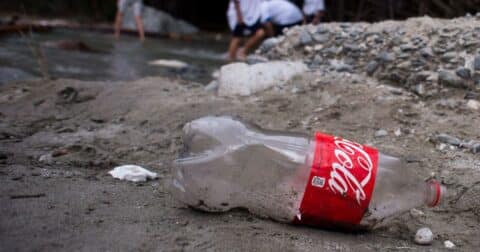Feature
Maine Was First to Ban Spreading PFAS-Contaminated Sludge on Farmland. Now Sludge Is Filling up Landfills.
Health•19 min read
Explainer
Microplastics have become part of the food chain.


Words by Julieta Cardenas
Microplastics are tiny pieces of plastic less than 5mm in size. Small and ubiquitous — they are only about as thick as a paperclip — microplastics have been detected in our water supply, agricultural soils and the farm animals we raise for food. One study suggests the presence of microplastics might be anywhere from 4 to 23 times higher in farm soils than in waterways. Whether in soils or water, plastic pollution flows throughout our food system, Brett Nadrich, communications officer for Break Free From Plastic, tells Sentient, and “we have to turn off the tap.”
Break Free From Plastic is an international advocacy group working to combat plastic pollution. “More than 99 percent of plastics are made of fossil fuels that used to be mostly oil,” Nadrich says. Now it is also made from fracked gas, he says. In the communities of West Pennsylvania, Appalachia, the Gulf, Louisiana and Texas, “you’re already seeing toxic chemicals entering the water table.” Pollution from fracking extraction sites settles on soil as particulate matter, Nadrich says, which is then absorbed by plants and animals, including crops and farm animals.
In 2022, Break Free From Plastic released a brand audit to identify the top plastic polluting corporations for the past five years, naming Coca-Cola as the top contributor to the plastic problem, followed by Pepsi-Co and Nestlé, among others. These corporations produce a wide range of products, including packaged meats, dairy and also plant-based brands.
Foods packaged in plastic can end up in the food itself. In one example, researchers tested cuts of meat and found plastics that matched the surrounding wrapping and polystyrene trays.
One of the more surprising ways plastics end up in the food system happens on livestock farms in a practice called garbage feeding. Legal in 27 states, the practice is shown in a 2022 video taken by a maintenance technician at a grain elevator owned by Smithfield, where bread in plastic wrappers was being processed into feed. The video went viral, and an executive from Smithfield responded to say most plastic is vacuumed out onsite. The technician disagreed, but there is no agency that inspects or oversees the process to tell for sure.
Garbage feeding sometimes results in wrapped food from schools, bakeries and markets thrown directly into a shredding machine, churned up, plastic and all, to be fed later to pigs. From there, the plastic ends up in the pigs, in turn slaughtered for pork for human consumption.
There are a host of other ways that plastics end up traveling through the food system. On farms, plastics break down into microplastics thanks to a variety of factors — exposure to sunlight, farm animals brushing up against on-farm plastic and from agricultural practices like adding compost that contains plastic, and fertilizer and using mulch film.
Mulch film, often used to prevent weeds and conserve water, ends up deteriorating, and need to be prelaced every one to two years, when the process starts all over again.
Researchers have also found that plants, including crops fed to farm animals, are capable of accumulating microplastics, absorbing them from the soil. Some farm animals like poultry are also fed feed derived from marine sources like fishmeal and seaweed, and these too can contain microplastics.
Microplastics have also been detected in the feces of various domestic animals, including sheep, dairy cows, poultry and pigs. The microplastics in animal waste re-enter the food system when applied to fields, and in turn can also leach into nearby water sources. Irrigation can also bring microplastics into agricultural soils, especially when it contains waste water, either from humans or from factory farms.
According to a 2022 report from the Center for International Environmental Law, another source are synthetic fertilizers and pesticides that are encapsulated in a plastic coating and marketed as “controlled-release.” Much like slow release pills, they break down in the soil, releasing not only the pesticide or fertilizer, but the plastic into the ground.
Though the exact human health risks of microplastics are not known, some studies have found microplastics present in patients with adverse health outcomes, like cancer and cardiovascular disease. Another study found more microplastics in recent tissue samples as compared to those taken ten years earlier. As toxicology researcher Phoebe Stapleton told People magazine, “while it might not affect my health today, it may affect my health in 50 years.”
While researchers and advocates have a variety of recommendations for reducing individual plastic use — like shifting to reusable bottles and filtered tap water rather than bottled — it will likely take a policy intervention to curb plastic pollution. The Biden administration issued a briefing on plastic pollution over the summer, but there are few signs the incoming Trump administration will carry on those policies.